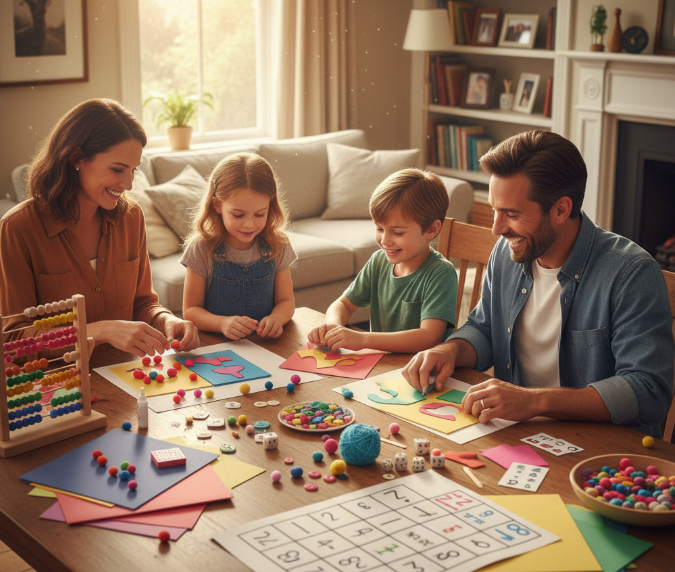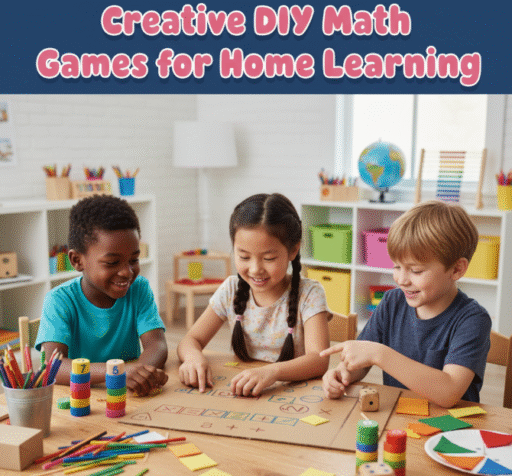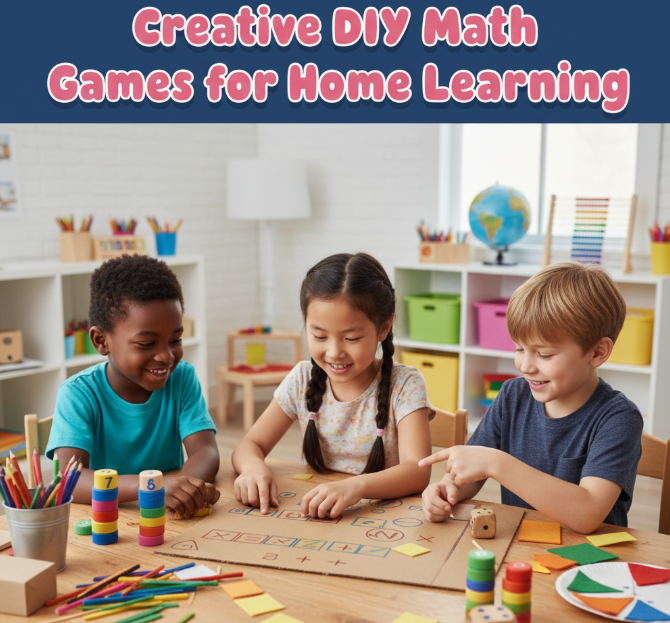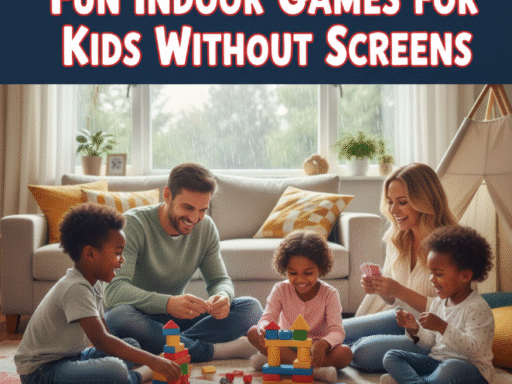Introduction
Math doesn’t have to be a boring subject filled only with textbooks and worksheets. In fact, one of the best ways to build a child’s confidence in math is by turning it into play. When kids engage with DIY math games at home, they’re not just learning formulas and rules—they’re practicing problem-solving, logical thinking, and creativity in fun and exciting ways.
The beauty of do-it-yourself math games is that they require little more than everyday items like paper, dice, playing cards, or even bottle caps. Parents can easily set these games up at home, and kids can join in without feeling like they’re doing “schoolwork.” Instead, it feels like a fun family activity that still teaches critical math skills.
This article will guide you through creative, hands-on math games you can set up at home for kids of different age groups. You’ll find ideas for addition, subtraction, multiplication, division, fractions, geometry, and even algebra basics—presented in ways that are playful and memorable.
Why DIY Math Games Work
Before we dive into the activities, let’s quickly look at why homemade math games are such a powerful learning tool.
-
Hands-on engagement: Kids use physical objects, which makes abstract concepts more concrete.
-
Multi-sensory learning: Seeing, touching, and moving objects helps improve memory.
-
Stress-free practice: Games reduce the anxiety that often comes with traditional math lessons.
-
Family bonding: Parents and siblings can play together, making math a social and enjoyable experience.
-
Customization: DIY games can be adjusted to match the child’s age, level, and interests.
Everyday Items That Double as Math Tools
Before creating the games, gather a few common items:
-
Dice
-
Deck of playing cards
-
Colored beads, buttons, or bottle caps
-
Paper, markers, sticky notes
-
Measuring tape or ruler
-
Dominoes
-
Jenga blocks or LEGO bricks
-
Coins
These simple materials are more than enough to create hours of math fun at home.
Fun DIY Math Games by Skill Level
Let’s break down creative math activities into categories so parents can pick games that target the skills their child needs most.
1. DIY Games for Early Math Skills (Addition & Subtraction)
A. Dice Race
-
How to play:
-
Roll two dice.
-
Add the numbers together.
-
Move that many steps on a homemade number line drawn on paper.
-
-
Skills practiced: Number recognition, addition, quick mental math.
-
Variation: Use three dice for higher numbers.
B. Bottle Cap Math Match
-
Setup: Write numbers on bottle caps and matching addition/subtraction problems on paper.
-
How to play: Kids place the correct bottle cap on the matching problem.
-
Why it works: Kids love the hands-on matching element, and parents can make endless variations.
C. Card Flip Addition
-
Use a deck of cards (remove face cards).
-
Flip two cards and add them together. Whoever gets the highest sum wins the round.
-
Bonus round: Flip three cards for more challenging sums.
2. DIY Multiplication and Division Games
A. Multiplication War (Card Game)
-
Remove face cards from a deck.
-
Two players flip two cards each. Multiply them.
-
Whoever has the highest product wins both sets of cards.
-
Play until the deck is gone.
B. LEGO Division Towers
-
Materials: LEGO bricks in different colors.
-
How to play:
-
Give the child a “problem” (e.g., divide 12 into groups of 3).
-
The child builds towers to show equal groups.
-
-
Concepts learned: Division as sharing, multiplication as repeated addition.
C. Spin and Multiply
-
Draw a circle divided into 10 sections (like a spinner). Label sections 1–10.
-
Spin twice and multiply the numbers.
-
Kids write down answers on a score sheet—whoever gets the most correct in 5 rounds wins.
3. Fraction & Decimal DIY Games
A. Fraction Pizza
-
Draw circles on cardboard and cut them into halves, thirds, fourths, etc.
-
Kids “build pizzas” by matching slices.
-
You can also add toppings (paper pepperoni, olives, cheese pieces) to show equivalent fractions.
B. Measuring Cup Challenge
-
Using real kitchen tools, give kids fraction tasks like:
-
Fill 1/2 cup of rice.
-
Combine 1/4 and 1/4 cup to make 1/2.
-
-
Why it’s powerful: Kids physically see how fractions work in everyday life.
C. Decimal Shopping Game
-
Create a pretend store using items labeled with prices like $1.25, $0.75, etc.
-
Kids “shop” with a set amount of fake money and calculate totals.
-
Builds decimal addition, subtraction, and money-handling skills.
4. Geometry & Shape Games
A. Shape Hunt Around the House
-
Create a checklist: square, rectangle, triangle, circle, hexagon.
-
Kids walk around the house finding matching objects (e.g., a clock = circle).
-
Bonus: Measure sides of objects for perimeter practice.
B. Tangram DIY Puzzle
-
Cut out 7 tangram shapes from cardboard.
-
Challenge kids to form animals, houses, or objects using all 7 pieces.
-
Enhances spatial reasoning and geometry understanding.
C. 3D Shape Building with Toothpicks
-
Use marshmallows or clay as joints and toothpicks as edges.
-
Build cubes, pyramids, and prisms.
-
Discuss vertices, edges, and faces.
5. Algebra Basics Made Fun
A. Balance the Scale (Equation Game)
-
Draw a balance scale on cardboard.
-
Place numbers on one side and ask kids to balance with missing numbers (e.g., 3 + ? = 7).
-
Introduces algebraic thinking naturally.
B. Mystery Number Box
-
Write a number in a box (hidden). Give clues like:
-
“It’s greater than 10 but less than 20.”
-
“It’s divisible by 3.”
-
-
Kids solve by narrowing down possibilities.
C. Equation Dominoes
-
Make DIY domino cards with equations on one side and answers on another.
-
Kids line them up by solving correctly.

Creative DIY Math Games for Home Learning
Comparison Table of DIY Math Games
| Math Area | Example Game | Materials Needed | Skills Built | Age Group |
|---|---|---|---|---|
| Addition/Subtract | Dice Race, Card Flip | Dice, cards, paper | Mental math, number sense | 5–8 yrs |
| Multiplication | Multiplication War | Playing cards | Fast recall, multiplication facts | 7–10 yrs |
| Fractions | Pizza Fractions, Cooking | Cardboard, cups, food | Fraction values, equivalence | 8–11 yrs |
| Geometry | Shape Hunt, Tangrams | Paper, toothpicks, clay | Shapes, spatial reasoning | 6–12 yrs |
| Algebra | Balance Game, Dominoes | Paper, scales, cards | Equation solving, logical thinking | 9–13 yrs |
Tips for Parents to Maximize Learning
-
Keep it short and fun: 10–15 minutes daily is better than long sessions.
-
Let kids lead: Ask them to create their own version of a game.
-
Use real-life examples: Grocery shopping, cooking, or sports scores make math relatable.
-
Celebrate effort, not just answers: Praise problem-solving even if the solution isn’t perfect.
-
Mix up the games: Rotate activities to keep kids excited.
Creative Extensions for Older Kids
Older kids can enjoy math games too—just add complexity.
-
Use two-digit multiplication in card games instead of single-digit.
-
Challenge with decimal fractions in shopping or cooking games.
-
Add a timer for speed-based competitions.
-
Turn math into family game night with scoreboards and small prizes.
How DIY Math Games Support Different Learning Styles
-
Visual learners: Get diagrams, shapes, and written numbers.
-
Auditory learners: Benefit when parents talk through the problems.
-
Kinesthetic learners: Thrive with hands-on tools like dice, LEGO, or bottle caps.
This adaptability makes DIY math games suitable for almost every child.
Infographic: The DIY Math Game Approach
Imagine a simple infographic showing this cycle:
Everyday Item → Creative Game → Math Concept → Confidence Growth
Example: Dice → Dice Race → Addition Practice → Faster Mental Math
This simple cycle shows how ordinary items transform into powerful learning experiences.
Conclusion
Math isn’t just about memorizing multiplication tables or solving worksheets. With a little creativity, it can become one of the most enjoyable subjects for kids. DIY math games allow parents to bring numbers, shapes, and equations into everyday life in playful, hands-on ways.
From fraction pizzas and card multiplication wars to geometry hunts and algebra dominoes, these activities help children build critical math skills while having fun at home.
So next time your child groans about math homework, pull out some dice, cards, or bottle caps—and let the learning begin through play. Because when kids enjoy math, they don’t just get better at it—they start to see themselves as confident problem-solvers in every part of life.




